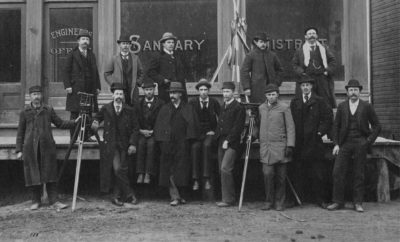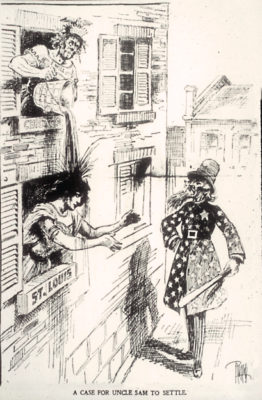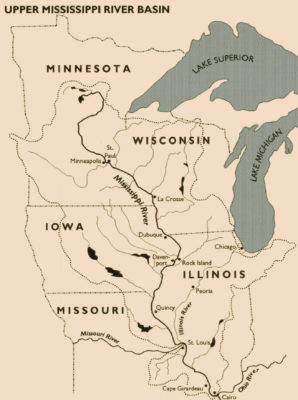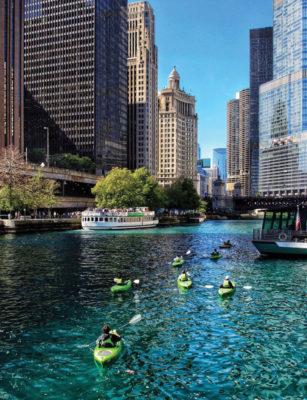By the end of the nineteenth century, civil engineers had created the Suez Canal, London’s sewers, and the steel-truss Eads Bridge across the Mississippi River. For the City of Chicago, the time was ripe for an ambitious new drainage canal to handle heavy rains that flooded sewers under the flat prairie and surged polluted water into Lake Michigan. Around the globe, the ravages of waterborne pandemics such as cholera and typhoid fever had marred the century.
The city was impelled to protect its drinking water supply by advances in bacteriology and popular understanding of the link between germs and illness. Roused by a corresponding concern, the neighboring State of Missouri sought to stop Chicago’s waste from arriving at its doorstep. Health and science dominate this legal story and they guide environmentalism
and the law today.
Juxtaposed with the modern Clean Water Act, Part 2 of this article looks at property law’s classic doctrine of nuisance in Missouri v. Illinois, the U.S. Supreme Court’s “first transboundary pollution dispute” (Percival, 2004). With empathy for our forebears who feared a deadly disease, we will consider the law’s evolving ability to confront environmental harm.
Sanitary and Ship Canal

Survey instruments and equipment, Sanitary District of Chicago field office, 1895. Courtesy of Metropolitan Water Reclamation District of Greater Chicago.
Chicago’s solution to its drainage problem was a canal with vastly greater capacity than the mid-century Illinois and Michigan (I&M) Canal. The Illinois Legislature created the Sanitary District of Chicago for this purpose, and construction began in 1892 on what was eventually named the Sanitary and Ship Canal (herein “Ship Canal”). (1889 Ill. Laws 126.) It would be 160 feet wide and deep enough to accommodate seagoing ships traveling between Lake Michigan and the Mississippi River, compared to the small boats that plied the I&M Canal.
Not just for transportation, the Ship Canal was built to export the growing city’s sewage and industrial waste downstate, and to permanently reverse the Chicago River to flow away from its mouth at Lake Michigan. The reversal flushed and diluted the waste with hundreds of thousands of cubic feet per minute of lake water (Leighton, USGS, 1907).

Water intake towers at Chain of Rocks on the Mississippi River, St. Louis waterworks (built 1894 and 1915). Photo by Mark Schuver.
Within days after the new year, 1900, the Ship Canal opened and Missouri filed its lawsuit asking the Supreme Court to enjoin the transport of wastewater into its territory. The canal, the suit described, “connects with and empties into the Des Plaines River, which empties into the Illinois River, and which … empties into the Mississippi River at a point distant about 43 miles above the City of St. Louis.” (180 U.S. 208.)
“The Memory of Man”
The parties appeared before the high court twice. First, the justices considered Missouri’s prayer for a temporary injunction to prevent the consequence it feared: that the Mississippi River “will of a certainty be poisoned” by Chicago’s sewage. Adducing time-honored dependence on its border river, Missouri argued its people will be deprived of water that had been enjoyed “for the length of time that the memory of man runneth.”
The Court acknowledged its equitable powers to “prevent nuisances that are threatened, and before irreparable mischief ensues.” However, it held that the evidence at this early stage of the Ship Canal did not justify such a remedy, because when seeking to prevent injuries merely apprehended, any “conflict and doubt will be grounds for withholding an injunction.” The Court allowed the case to be retried later.
Annoyance

A line of workers move rubble during construction of Chicago Sanitary & Ship Canal, 1899, at Lemont Railroad Bridge. The canal cut through Silurian-age limestone bedrock. Courtesy of Metropolitan Water Reclamation District of Greater Chicago.
Missouri’s lawsuit alleged a public nuisance. While private nuisance is an interference with private rights in land, public nuisance “affects a large community.” (Arizona Copper Co. v. Gillespie, 230 U.S. 46 (1913).) Although they share a word, the concepts actually have different origins. Private nuisance stems from the Roman maxim: Use your own property in such a manner as not to injure that of another (abbr. sic utere, “use it thus”). (Id.; Lucas v. S.C. Coastal Council, 505 U.S. 1003 (1992).)

Coal barge on Sanitary & Ship Canal at Lemont Railroad Bridge, 1949, Lemont, IL. From the American Geographical Society Library, University of Wisconsin-Milwaukee Libraries.
Public nuisance historically involved obstructing the King’s Highway, or “doing a thing which tends to the annoyance of all the King’s subjects.” (Wm. Hawkins, 1716; Prosser, 1941; Lucas, dissent fn. 15.) It has expanded to enforce a variety of public rights and can give rise to both civil and criminal liability. “[P]ublic nuisance law, like common law generally, adapts to changing scientific and factual circumstances.” (American Elec. Power Co. v. Connecticut, 564 U.S. 410 (2011).)
But nuisance has its shortcomings. Fighting polluters one lawsuit at a time is costly, uncertain, and an unreliable means of deterrence. Further, nuisance is ill-equipped to deal with regional and national problems. Indeed, the practice of dumping filth into rivers was at the time so commonplace, the Court in Missouri v. Illinois observed the irony that “if this suit should succeed, [Plaintiff Missouri] not improbably would find itself a defendant to a bill by one or more states lower down [the river].” (200 U.S. 496.) Interstate conflict was inevitable absent national water quality standards.
Save Our Lake!
Municipal sewage persisted as a major cause of pollution until the environmental movement—embodied by Earth Day in 1970—spurred a series of landmark federal laws. Among them, the Clean Water Act was partly brought about by a campaign to save Lake Michigan, which had suffered from the effects of invasive species via the Ship Canal and decades of dumping of toxic and chemical waste (Platt, 2017).
The Clean Water Act prohibits adding pollutants into waters of the United States from a “point source,” except with a permit. (33 U.S.C. § 1311.) “Point source” is defined as a “discrete conveyance,” like a pipe, canal, or well—a term aimed at causes of pollution that “may readily be controlled,” such as effluent from a factory. (United States v. Plaza Health Laboratories, 3 F.3d 643 (2d Cir. 1993).)
“Waters of the U.S.” encompasses navigable rivers and territorial seas, as well as connecting features, such as certain streams and wetlands. (Rapanos v. United States, 547 U.S. 715 (2006) (Scalia, J., plurality opinion).) Essentially, protecting the “integrity of the Nation’s waters” requires regulating beyond what is strictly navigable; otherwise, pollutants will inexorably reach a larger body and negate the law’s effect. (§ 1251(a).)
Maui County

Coral reef and school of Hawaiian convict tang at Kahekili Beach Park, Maui, Hawaii. Photo by Jason Moore.
In Missouri, the Supreme Court considered the time and distance that sewage traveled and whether harmful particles “survive the journey.” More than a century later, the Court examined those same factors in County of Maui v. Hawaii Wildlife Fund, 140 S.Ct. 1462 (2020), a case that clarifies when a pollutant discharge, though indirect, may still need a permit. The permit is the key to the Clean Water Act (§ 402), because it allows the government to limit discharges in order to meet water quality standards, and, in the case of sewage, to control its treatment before it is released to the environment.
Maui County involved a county sewage treatment plant located half a mile from the Pacific Ocean. If effluent had been piped to the water’s edge, this would clearly be a direct discharge “from a point source” to the water. But the plant did something different. It forced the treated wastewater into groundwater 200 feet below grade via injection wells, enabling the effluent to join the groundwater on its natural migration to the ocean. The question was whether the final outfall should be viewed as from a point source. If so, then a permit was required.
Environmental organizations sued the county for discharging a pollutant without a permit. The trial court ruled against the county and the Ninth Circuit affirmed, the latter holding that a permit is required when “pollutants are fairly traceable from the point source.”
From a Point Source
“The parties disagree dramatically,” Justice Stephen Breyer wrote in the high court’s opinion in Maui County, “about the scope of the word ‘from’ in the [statute].” (§ 1362(12).) The county argued for a narrow interpretation: that “any amount of groundwater between the end of the pipe and the edge of the navigable water” would mean that the pollutant did not come immediately from the pipe or well. The Court rejected this interpretation as extreme and allowing an “obvious loophole”: that to avoid the permit, a polluter could “simply move the pipe back, perhaps only a few yards … before reaching the sea.”
The environmental groups agreed with the court of appeal’s standard: to require a permit when the pollutant is “fairly traceable” to a point source. Tracer dye experiments by EPA and university scientists demonstrated the hydrologic connection between the county wells and the ocean: “Fluorescein dye … was first detected [emerging] at Kahekili Beach’s nearshore seeps 84 days after being placed in the wells.” (Pl. App. Br., C.A.9.)
But the Court reasoned that “fairly traceable” was also too extreme. “Given the power of modern science,” the Court said this standard could give the EPA broad authority over “pollutants that reach navigable waters many years after their release … and in highly diluted forms.”
Instead, the Court adopted a middle approach and remanded to the lower court to apply a list of factors that would help determine whether the county’s discharge to the ocean is “the functional equivalent of a direct discharge.” The Court suggested that time and distance were likely to be the most important factors, and it identified others that may be relevant, such as whether the pollutant “is diluted or chemically changed as it travels.”
“Inference of the Unseen”

“Valley of the Minnesota and Mississippi Rivers,” by American Photo-Lithographic Co., ca. 1884, compiled from surveys by Maj. Gen. G.K. Warren (Bridging the Mississippi River Between St. Paul and St. Louis; NYS Lib. Mss & Special Coll.). Prints Old & Rare, Pacifica, CA
In 1906, five years after Missouri’s request for preventive relief was denied, the states had completed what the Court described as “the most ingenious experiments … of modern science.” The Court’s opinion by Justice Oliver Wendell Holmes exudes a newfound appreciation of science and recognition of the problem of pollution at the start of a new century.
Acknowledging that this science-based claim was unlike “the simple kind that was known to the older common law,” the Court said:
There is nothing which can be detected by the unassisted senses—no visible increase of filth, no new smell. On the contrary, it is proved that the great volume of pure water from Lake Michigan, which is mixed with the sewage at the start, has improved
the Illinois River in these respects ….

St. Louis pleads to Uncle Sam to redress harm from Chicago’s waste in news cartoon the week Missouri filed its lawsuit. St. Louis Globe-Democrat, January 14, 1900
Rather, Missouri’s case “depends upon an inference of the unseen.” As to the allegation that deaths in St. Louis were attributable to pathogens, the Court accepted “the now-prevailing scientific explanation of typhoid fever to be correct.” However, “beyond that assumption”—in particular whether the danger issued from Chicago—the Court said that “everything is … in doubt.”
Engineers testified as to the time it took sewage to make its way 357 miles from Chicago’s Ship Canal to St. Louis’s water intake at Chain of Rocks. Instead of tracer dye, they used “floats”—“the lower portion consisting of metal-plate vanes … connected to the buoyant part by a chain” and topped with a flag—which were observed taking from eight to 18½ days (Leighton).
Chemistry experiments proffered by each side to show whether Bacillus typhosus remained viable after such a trek were controverted. In one experiment, Missouri’s expert emptied over a hundred barrels into the Ship Canal of identifiable bacteria “broth” (Kids, don’t try this at home!), of which he reported detecting traces a month later at the St. Louis intake (id.). Illinois claimed these results actually supported its position that any minute remnants of typhoid “would be scattered and enfeebled and would do no harm.”
A Great River
Most compelling, Missouri’s case was hurt by the everyday practices of its own cities. The Missouri River transects the state before reaching the Mississippi, and both rivers served as “sewers of the cities along their banks.” Illinois contended persuasively “that if there is any trouble, the plaintiff must look nearer home for the cause.”
The Court held that Missouri had failed to prove its case. But the Court took note of the wide-reaching menace, and did not mince words on a matter potentially “of international importance[:] a visible change of a great river from a pure stream into a polluted and poisoned ditch.” It urged the necessity for “preventive measures, by filtration or otherwise, against the dangers of the plaintiff’s own creation” and from other sources.
Epilogue
As Justice Holmes speculated in Missouri, more lawsuits arising out of interstate water pollution followed. In 1972, Illinois (now the plaintiff) sued Wisconsin cities, alleging their sewage discharges into Lake Michigan created a public nuisance. Ultimately, the Supreme Court held that such claims had been supplanted by the Clean Water Act. (City of Milwaukee v. Illinois & Michigan, 451 U.S. 304 (1981).) The Court cited Congress’ intent to legislate “a comprehensive long-range policy for the elimination of water pollution.” This left no room for “ad hoc” judicial remedies in nuisance cases under federal common law. The sewage that Illinois complained of “has been thoroughly addressed” by the law’s permit regime, the Court said.
We have seen the difficulty of proving causation in Missouri, the Court’s seeming relief in Milwaukee at no longer acting
as the primary bulwark against interstate pollution, and a case in point on the Clean Water Act in Maui County.
Today, wastewater is largely controlled thanks to science and technology, environmental advocacy, and the law. There is more to do, but with that support the Chicago and Mississippi Rivers aspire to the legislative goal of being healthy enough for wildlife, fishing and swimming.
Bibliography
Harold L. Platt, “‘A Ridiculous Failure of Government’: The Chicago River in the Age of Ecology.” In M. Knoll et al. (Eds.), Rivers Lost, Rivers Regained: Rethinking City-River Relations (Univ. of Pittsburgh Press, 2017).
Town of Cicero v. Metro. Water Reclamation Dist. of Greater Chicago, 976 N.E.2d 400 (2012).
Lloyd Pilchen is a partner at Olivarez Madruga Lemieux O’Neill llp in Los Angeles and serves as legal counsel for cities and public agencies. He is a California and Illinois surveyor. Law Land Lines™ offers Lloyd’s take on the law.


